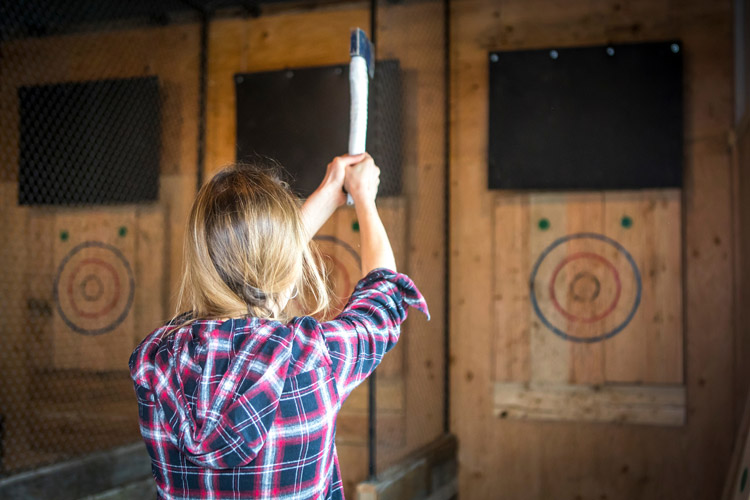Axe Throwing Denver: Remarkable Company Occasions and Team Building
Axe Throwing Denver: Remarkable Company Occasions and Team Building
Blog Article
The Fun of Axe Throwing: How This Sporting Activity Incorporates Ability and Adrenaline for a Good Time
Axe throwing has emerged as an astounding sporting activity that masterfully links the need for specific skill with the rush of adrenaline, offering individuals a distinct and interesting experience. The act of tossing an axe in the direction of a target requires focus and method, concurrently fostering an ambience of friendship and pleasant rivalry.
The Beginnings of Axe Throwing
Axe throwing, a recreational task that has gotten substantial appeal in recent years, traces its origins back to ancient times. The earliest documents of axe use in affordable contexts are discovered amongst the Celts and Vikings, who tossed axes for sporting activity as well as in battle training.
Middle ages European warriors, particularly throughout the Center Ages, exercised axe tossing as part of their martial training. The Francisca, a kind of tossing axe utilized by the Franks, came to be iconic for its dangerous precision. This conventional tool was made to be tossed at opponent guards and armor, showcasing its dual utility in both sporting activity and fight.
In more current history, axe tossing saw a revival in the logging camps of The United States and copyright in the 19th and 20th centuries. Lumberjacks would participate in pleasant competitors, testing their accuracy and strength by aiming at wood targets. This development from a survival skill to a leisure task has actually led the way for its modern-day renewal, with dedicated locations and leagues currently celebrating the sporting activity globally.
Tools You Required
Recognizing the abundant history of axe throwing boosts the recognition of the sport's modern version. For recreational and affordable axe tossing, the most typically made use of kind is the hatchet, usually evaluating in between 1.25 to 2 extra pounds with a manage size of about 16 inches.
Just as crucial is the target. Law targets are built from timber, with softwood varieties like want or cottonwood being preferred for their capability to hold the axe and take in. The target is usually split into five concentric circles, each with a particular factor value, to facilitate scoring.
Safety and security equipment, however commonly forgotten, is crucial. Protective gloves can improve grip and prevent sores, while closed-toed shoes are a must to shield feet from dropped axes (axe throwing denver). Finally, a well-lit, spacious throwing area, full with safety barriers, makes certain a regulated atmosphere where participants can concentrate on refining their skills.
Standard Techniques Explained
Understanding the basic techniques of axe throwing is essential for both security and efficiency. The initial technique to comprehend is the grip. Hold the axe with a firm, yet unwinded grip, similar to holding a golf club. The leading hand needs to be placed directly below the axe head, while the non-dominant hand supports the end of the manage.
Following, concentrate on the stance. Stand with your feet shoulder-width apart, ensuring your body is balanced. Your dominant foot must be a little ahead, lining up with your target. This positioning aids in preserving security and guiding power precisely towards the target.

Safety First
Making certain security in axe throwing is critical to developing an injury-free and satisfying experience. A well-designed axe throwing center attributes clear separations in between tossing lanes, durable backgrounds to catch stray axes, and non-slip flooring to protect against mishaps.
Advantages of Axe Throwing
Axe throwing deals a myriad of benefits that prolong beyond easy recreation. The repetitive motion of tossing the axe likewise boosts hand-eye sychronisation and great motor abilities.
Emotionally, axe throwing calls for precision, approach, and focus, making it an exceptional way to sharpen cognitive abilities. The concentration required to hit the target can offer as a kind of mindfulness, enabling individuals to remove their minds and decrease anxiety. This psychological interaction can be particularly advantageous in helping individuals create far better problem-solving abilities and mental strength.
Socially, axe throwing is commonly enjoyed in group setups, cultivating team-building and sociability. Whether as part of a business event or a casual outing with close friends, the sport urges interaction and cooperation. Additionally, the communal experience of learning and boosting with each other can enhance partnerships and produce long lasting memories.
Conclusion

The earliest documents of axe use in affordable contexts are found among the Celts and Vikings, that threw axes for sporting activity as well as in fight training. Release the axe when your hands are roughly at eye degree, enabling the axe's all-natural turning to direct it in the direction of the target.
A well-designed axe throwing facility attributes clear separations in between throwing lanes, strong backgrounds to catch roaming click here now axes, and non-slip flooring to protect against crashes. Individuals must be advised on the proper means to throw the axe and take care of, highlighting controlled, deliberate movements over forceful tosses.
In summary, axe tossing stands out as a sporting activity that masterfully integrates accuracy, adrenaline, and ability.
Report this page